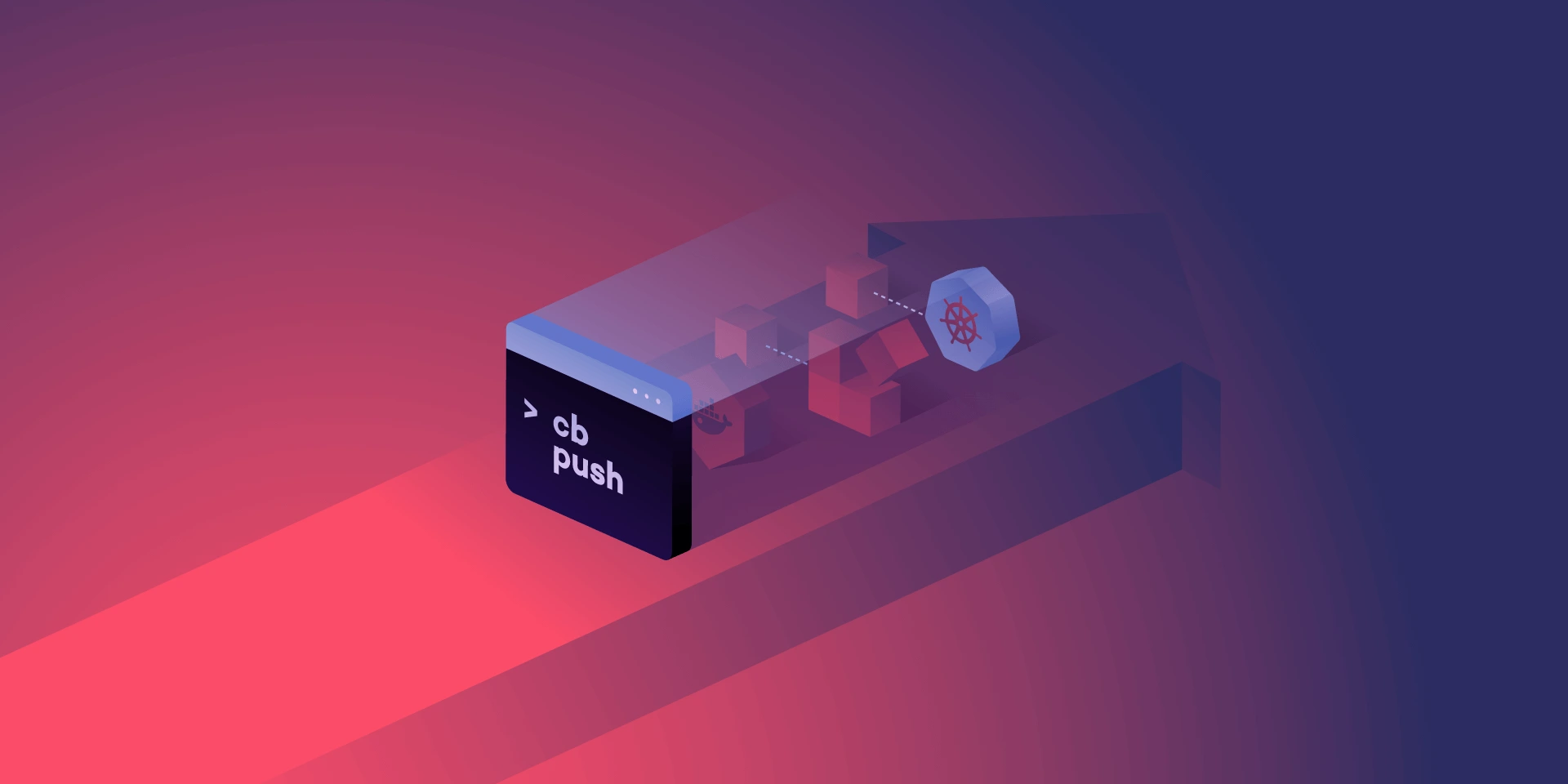Kubernetes Cluster Management: Size and Resources

While managing Kubernetes clusters, we can face some demanding challenges. This article helps you manage your cluster resources properly, especially in an autoscaling environment.
If you try to run a resource-hungry application, especially on a cluster which has autoscaling enabled, at some point this happens:
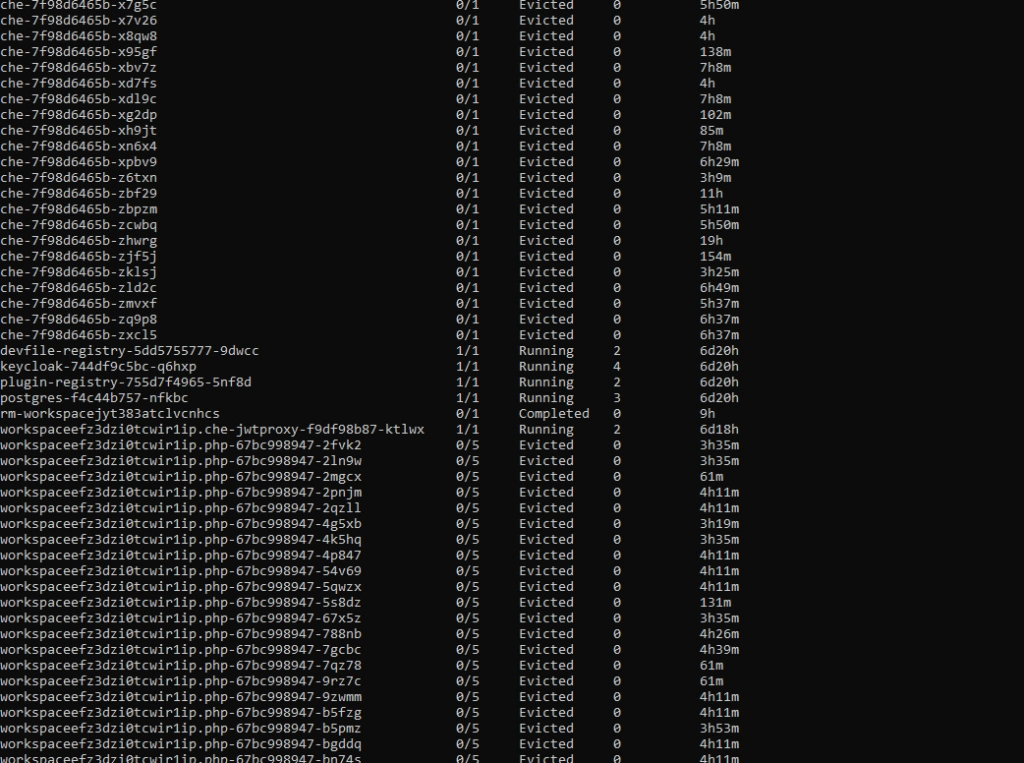
For the first time, it may look bad, especially if you see dozens of evicted pods in kubectl get, and you only wanted to run 5 pods. With all that claims, that you can run containers without worries about the orchestration, as Kubernetes does all of that for you, you may find it overwhelming.
Well, this is true to some extent, but the answer is – it depends, and it all boils down to a crucial topic associated with Kubernetes cluster management. Let’s dive into the problem.
Learn more about services provided by Grape Up
You are at Grape Up blog, where our experts share their expertise gathered in projects delivered for top enterprises. See how we work.
Enabling the automotive industry to build software-defined vehicles
Empowering insurers to create insurance telematics platforms
Providing AI & advanced analytics consulting
Kubernetes Cluster Resources Management
While there is a general awareness that resources are never limitless – even in a huge cluster as a service solution, we do not often consider the exact layout of the cluster resources. And the general idea of virtualization and containerization makes it seem like resources are treated as a single, huge pool – which may not always be true. Let’s see how it looks.
Let’s assume we have a Kubernetes cluster with 16 vCPU and 64GB of RAM.
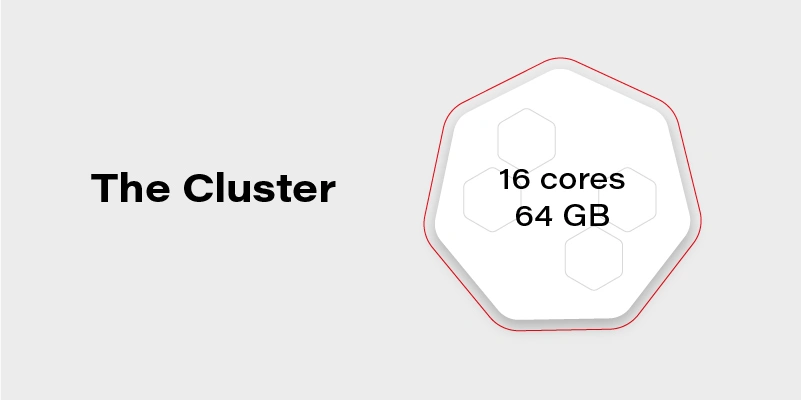
Can we run on it our beautiful AI container, which requires 20GB of memory to run? Obviously, not. Why not? We have 64GB of memory available on the cluster!
Well, not really. Let’s see how our cluster looks inside:
The Cluster Again
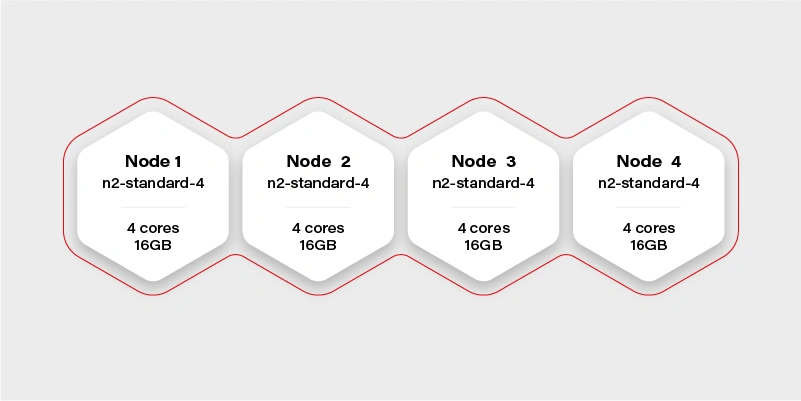
There are 4 workers in the cluster, and each has 16GB of memory available (in practice, it will be a little bit less, because of DaemonSets and system services, which run a node and take their small share). Container hard memory limit is, in this case, 16GB, and we can’t run our container.
Moreover, it means we have to always take this limitation into account. Not just if we deploy one big container, but also in complex deployments, or even things which in general can run out-of-the-box like helm charts.
Let’s try another example.
Our next task will be a Ceph deployment to the same cluster. The target we want to achieve is a storage size of 1TB split into 10 OSDs (object storage daemons) and 3 ceph MONs (monitors). We want to put it on 2 of the nodes, and leave the other 2 for deployments which are going to use the storage. Basic and highly extensible architecture.
The first, naive approach is to just set OSDs count to 10, MONs count to 3 and add tolerations to the Ceph pods, plus of course matching taint on Node 1 and Node 2. All ceph deployments and pods are going to have the nodeSelector set to target only nodes 1 and 2.
Kubernetes does its thing and runs mon-1 and mon-2 on the first worker along with 5 osds, and mon-3 along with 5 osds on the second worker.
| mon-1 mon-2 osd-1 osd-2 osd-3 osd-4 osd-5 |
mon-3 osd-6 osd-7 osd-8 osd-9 osd-10 |
Stateless App |
It worked out! And our application can now save quite a lot of large files to Ceph very quickly, so our job becomes easier. If we also deploy the dashboard and create a replicated pool, we can even see 1TB of storage available and 10 OSDs up, that’s a huge achievement!

The very next morning, we check the status again and see that the available storage is around 400GB and 4 OSDs in flight. What is going on? Is this a crash? Ceph is resilient, it should be immune to crashes, restart quickly, and yet it does not seem like it worked very well here.
If we now check the cluster, we can see a lot of evicted OSD pods. Even more, than we are supposed to have at all. So what really has happened? To figure this out, we need to go back to our initial deployment configuration and think it through.
Limits and ranges
We ran 13 pods, 3 of them (monitors) don’t really need a lot of resources, but OSDs do. More we use it more resources it needs because ceph caches a lot of data in memory. Plus replication and balancing data over storage containers do not come free.
So initially after the deployment, the memory situation looks more or less like this:
| Node 1 mon-1 – 50MB mon-2 – 50MB osd-1 – 200MB osd-2 – 200MB osd-3 – 200MB osd-4 – 200MB osd-5 – 200MB 1100MB memory used |
Node 2 mon-3 – 50M Bosd-6 – 200MB osd-7 – 200MB osd-8 – 200MB osd-9 – 200MB osd-10 – 200MB 1050MB memory used |
After a few hours of extensive usage, something goes wrong.
| Node 1 mon-1 – 250MB mon-2 – 250MB osd-1 – 6500MB osd-2 – 5300MB osd-3 – Evicted osd-4 – Evicted osd-5 – Evicted 12300MB memory used |
Node 2 mon-3 – 300MB osd-6 – 9100MB osd-7 – 5700MB osd-8 – Evicted osd-9 – Evicted osd-10 – Evicted 15100MB memory used |
We have lost almost 50% of our pods. Does it mean it’s over? No, we can lose more of them quickly, especially if the high throughput will now target the remaining pods. Does it mean we need more than 32GB of memory to run this Ceph cluster? No, we just need to correctly set limits so a single OSD can’t just use all available memory and starve other pods.
In this case, the easiest way would be to take the 30GB of memory (leave 2GB for mons – 650MB each, and set them limits properly too!) and divide it by 10 OSDs. So we have:
| resources: limits: memory: “3000Mi” cpu: “600m” |
Is it going to work? It depends, but probably not. We have configured 15GB of memory for OSDs and 650MB for each pod. It means that first node requires: 15 + 2*0.65 = 16.3GB. A little bit too much and also not taking into account things like DaemonSets for logs running on the same node. The new version should do the trick:
| resources: limits: memory: “2900Mi” cpu: “600m” |
Quality of Service
There is one more warning. If we also set a request for the pod to exactly match the limit, then Kubernetes treats this kind of pod differently:
| resources: requests: memory: “2900Mi” cpu: “600m” limits: memory: “2900Mi” cpu: “600m” |
This pod configuration is going to have QoS in Kubernetes set to Guaranteed. Otherwise, it is Burstable. Guaranteed pods are never evicted – by setting the same request and limit size, we confirm that we are certain what is the resource usage of this pod, so it should not be moved or managed by Kubernetes. It reduces flexibility for the scheduler but makes the whole deployment way more resilient.
Obviously, for mission-critical systems, “best-effort” is never enough.
Resources in an autoscaling environment
If we can calculate or guess the required resources correctly to match the cluster size, the limits and quality of service may be just enough. Sometimes though the configuration is more sophisticated and the cluster size is fluid – it can scale up and down horizontally and change the number of available workers.
In this case, the planning goes in two parallel paths – you need to plan for the minimal cluster size and the maximum cluster size – assuming linear scaling of resources.
It cannot be assumed that applications will act properly and leave space for the other cluster cohabitants. If the pods are allowed to scale up horizontally or vertically while the cluster is expanding, it may result in evicting other pods when it’s scaling down. To mitigate this issue, there are two main concepts available in Kubernetes: Pod Priority and Pod Disruption Budget.
Let’s start again by creating our test scenario. This time we don’t need tons of nodes, so let’s just create a cluster with two node groups: one consisting of regular instances (let’s call it persistent) and one consisting of preemptible/spot instance (let’s just call them preemptible for the sake of an experiment).
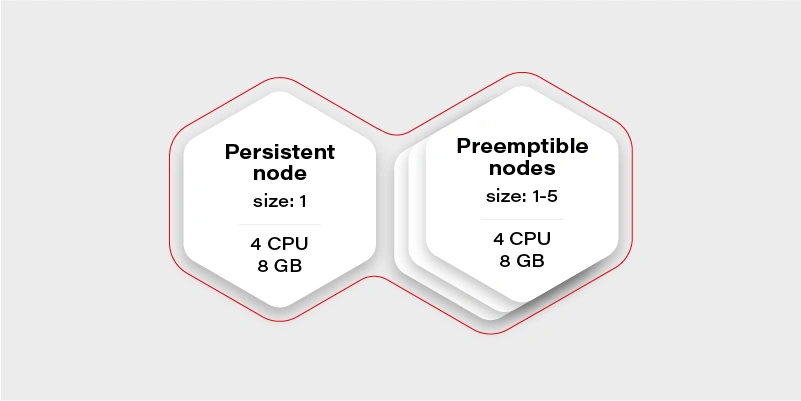
The preemptible nodes group will scale up when the CPU usage of the VM (existing node) will be over 0.7 (70%).
The advantage of the preemptible/spot instances is their price. They are much cheaper than regular VMs of the same performance. The only drawback is that there is no guarantee for their lifetime – the instance can be killed when the cloud providers decide it is required somewhere else, for maintenance purposes, or just after 24 hours. This means we can only run fault-tolerant, stateless workloads there.
Which should be most of the things which run in your cluster if you follow the 12 factors, right?
Why there is one persistent node in our cluster then? To prepare for the rare case, when none of the preemptible nodes are running, it is going to maintain the minimal set of containers to manage the operability of the application.
Our application will consist of:
| Application | Replicas | CPUs | Memory |
|---|---|---|---|
| Redis cluster with one redis master – has to run on a persistent node | 1 | 0.5 | 300MB |
| Frontend application (immutable) | 2 | 0.5 | 500MB |
| Backend application (immutable) | 2 | 0.7 | 500MB |
| Video converter application (immutable) | 1 | 1 | 2GB |
| Sum | 3.9 | 4.3GB |
We can configure the redis master to work on the persistent node using a node selector. Then just deploy everything else and Bob is your uncle.
Horizontal Pod Autoscaler
Well, but we have an autoscaling nodes group and no autoscaling configured in the cluster. This means we have never really triggered cluster autoscaling and it stays all the time on two workers, because application itself does not increase replicas count. Let’s start with the Horizontal Pod Autoscaler:
Frontend:
| apiVersion: autoscaling/v2beta2 kind: HorizontalPodAutoscaler metadata: name: frontend-hpa spec: scaleTargetRef: apiVersion: apps/v1 kind: Deployment name: frontend minReplicas: 2 maxReplicas: 10 metrics: – type: Resource resource: name: cpu target: type: Utilization averageUtilization: 75 |
Backend:
| apiVersion: autoscaling/v2beta2 kind: HorizontalPodAutoscaler metadata: name: backend-hpa spec: scaleTargetRef: apiVersion: apps/v1 kind: Deployment name: backend minReplicas: 2 maxReplicas: 10 metrics: – type: Resource resource: name: cpu target: type: Utilization averageUtilization: 75 |
Video converter:
| apiVersion: autoscaling/v2beta2 kind: HorizontalPodAutoscaler metadata: name: video-converter-hpa spec: scaleTargetRef: apiVersion: apps/v1 kind: Deployment name: video-converter minReplicas: 1 maxReplicas: 25 metrics: – type: Resource resource: name: cpu target: type: Utilization averageUtilization: 25 |
So now we have the same configuration as we described in the deployment – the sum of minReplicas is equal. Why does the video converter have such a low target average utilization? When there are multiple conversions enqueued, it will make autoscaling quicker – if it quickly reaches 25% of average CPU usage, then the new one is spawned. This is a very trivial configuration – if you need something more sophisticated check scaling policies.
What might happen if we now test our environment and enqueue 50 video conversions each taking around 10 minutes?
It depends, but the likely scenario is that the video converter will scale up to the 25 instances. What happens with other containers in the cluster? Some of them will be evicted, maybe backend ones, maybe frontend ones, or maybe even redis. There is quite a high risk of the setup to break down and be inaccessible for the end-users.
Can we mitigate the issue? Yes, for example, we can create the priority classes and assign them lower for the video converter. The higher priority pod has, the more worth it has for the scheduler. If two pods are due to be evicted – the one with lower priority gets the pole position. If two pods of different priorities are scheduled, the higher priority one gets the precedence.
| apiVersion: scheduling.k8s.io/v1 kind: PriorityClass metadata: name: high-priority value: 100000 globalDefault: false description: “This is high priority class for important workloads” |
So if we give the converter lower priority, we confirm that the frontend and backend pods are more important, and in the worst case, the video converter can be expelled from the cluster.
Moreover, this is not going to guarantee that the backend can’t evict the frontend.
There is also an alternative that allows us to have better control over the scheduling of the pods. It is called…
Pod Disruption Budget
This resource allows us to configure a minimal amount of the deployment pods running at once. It is more strict than just priority because it can even block the node drain, if there is not enough space on other workers to reschedule the pod, and in result make the replicas count lower than the assigned budget.
The configuration is straightforward:
| apiVersion: policy/v1beta1 kind: PodDisruptionBudget metadata: name: frontend-pdb spec: minAvailable: 2 selector: matchLabels: app: frontend |
From now on, the frontend replica count cannot get lower than 2. We can assign this way minimums for all the pods and make sure there are always at least 1 or 2 pods which can handle the request.
This is the easiest and safest way to make sure that pod autoscaling and cluster scaling down is not going to affect the overall solution stability – as long as the minimal set of containers configured with the disruption budget can fit the minimal cluster size and it is enough to handle the bare minimum of requests.
Connecting the dots
Now we have all the required pieces to create a stable solution. We can configure HPAs to have the same min number of replicas as PDB to make the scheduler’s life easier. We know our max cluster size and made sure limits are the same as requests, so pods are not evicted. Let’s see what we get with the current configuration:
| Application | Min. replicas | Max. replicas | PDB | CPUs | Memory |
|---|---|---|---|---|---|
| A redis cluster with one redis master – has to run on a persistent node | 1 | 1 | 1 | 0.5 | 300MB |
| Frontend application (immutable) | 2 | 10 | 2 | 0.5 | 500MB |
| Backend application (immutable) | 2 | 10 | 2 | 0.7 | 500MB |
| Video converter application (immutable) | 1 | 25 | 1 | 1 | 2GB |
| Sum (min) | 3.9 | 4.3GB | |||
| Sum (max) | 37.5 | ~60.3GB |
Not bad. It can even stay as it is, but the current max cluster size is 24 cores with 48GB of memory. With all the configurations we went through, it should be fine when we exceed that size, so there is a little bit of flexibility for the scheduler – for example if there is a very low load on frontend and backend, but a huge pile of data to be converted, then the converter can scale up to approx. 19-21 instances, which is nice to have.
There is no one design that fits all
Is there anything wrong with the current configuration? Well, there can be, but we are going into unknown depths of “it depends.”
It all starts with the simple question – what is the purpose of my solution/architecture and what are the KPIs. Let’s look again at the example – it is a video converted with a web application. A pretty basic solution that scales up if required to accommodate a higher load. But what is more important – faster conversion or more responsible UI?
It all boils down to the product requirements, and in general, it is easy to solve. There are three paths we can follow from now on:
The I don’t care path
If it does not matter from the user and product perspective just leave it and see how it performs. Maybe even two frontend pods can handle a lot of load? Or maybe nobody cares about the latency as long as nothing crashes unexpectedly? Don’t overengineer and don’t try the premature optimization – let it be and see if it’s fine. If it’s not there are still two other paths available.
The I know what matters most path
This path requires a bit of knowledge about priorities. If the priority is the smooth and scalable UI and it’s fine to have quite some conversions waiting – put the higher priority on the frontend and backend deployments as described in previous paragraphs. If the video conversion is the key – put the higher priority on it. Whatever you choose, it will be the deployment that can scale up at the expense of the other one. This is especially important if loads don’t really run in parallel most of the time, so can scale up and down independently, and the next path does not fit that scenario.
The I want to be safe path
The last path is straightforward, just put the maximums so to be close to the cluster limits, but not higher:
| Application | Min. replicas | Max. replicas | PDB | CPUs | Memory |
| A redis cluster with one redis master – has to run on a persistent node | 1 | 1 | 1 | 0.5 | 300MB |
| Frontend application (immutable) | 2 | 8 | 2 | 0.5 | 500MB |
| Backend application (immutable) | 2 | 8 | 2 | 0.7 | 500MB |
| Video converter application (immutable) | 1 | 13 | 1 | 1 | 2GB |
| Sum (min) | 3.9 | 4.3GB | |||
| Sum (max) | 23,1 | 34,3GB |
Now there is some space in the memory department, so we can, for example, give the pods more memory. We are also always safe because most of the time, there will be no fighting for resources. It might happen only when the cluster will be scaling up.
Is this a perfect solution? Not really, because it is possible to fit 20 video converters at once in the cluster when there is no traffic on the UI (frontend and backend) and we artificially limit the deployment ability to scale.
Autoscaling considerations
When it comes to autoscaling, there are some things to keep in mind. First, it is not reliable – it’s impossible to say how long it will take for the cloud provider to spin up the VM. It may take seconds, and it may take minutes (in general it rarely takes less than a minute), so starting very small with the hope of autoscaling solving the peak loads may not be the greatest idea.
The other often forgotten thing is that when we scale up, then there is a point when the cluster scales down. If the deployment scales down and pods are truly stateless and can handle it gracefully – then it is not a big deal. When it comes to the cluster scaling down, we need to remember that it effectively shuts down the VMs. Sometimes something is running on them, and the scheduler has to quickly move the workload to the other workers. This is something that has to be thoughtfully tested to make sure it does not break the application operations.
Kubernetes Cluster Management – Summary
This is the end of our quite long journey through Kubernetes cluster size and resources management. There is much more there, especially for the bigger clusters or complex problems, which may come in handy later on, like configuring the eviction policies, namespace requests and limits, or topology management useful when we have specific nodes for specific purposes. Although what we have gone through in this article should be perfectly fine and serve well even quite complex solutions. Good luck and we wish you no evicted pods in the future!
Check related articles
Read our blog and stay informed about the industry's latest trends and solutions.
see all articles

The State of Kubernetes – What Upcoming Months Will Bring For the Container Orchestration
Read the article




